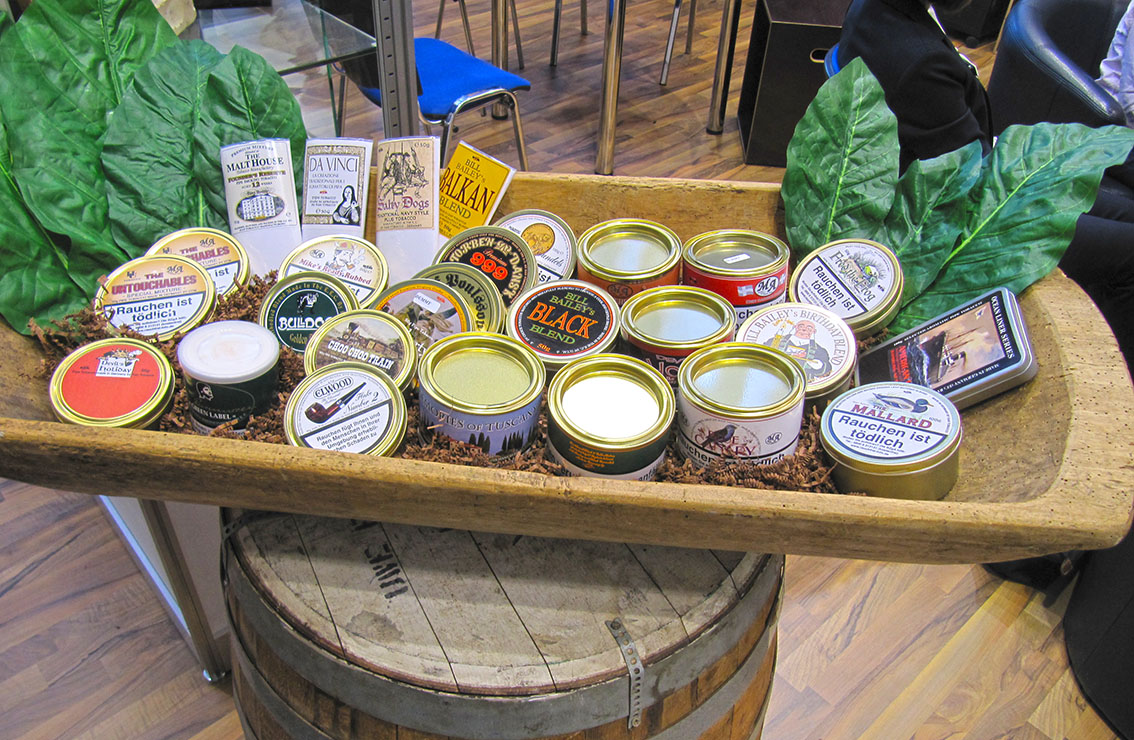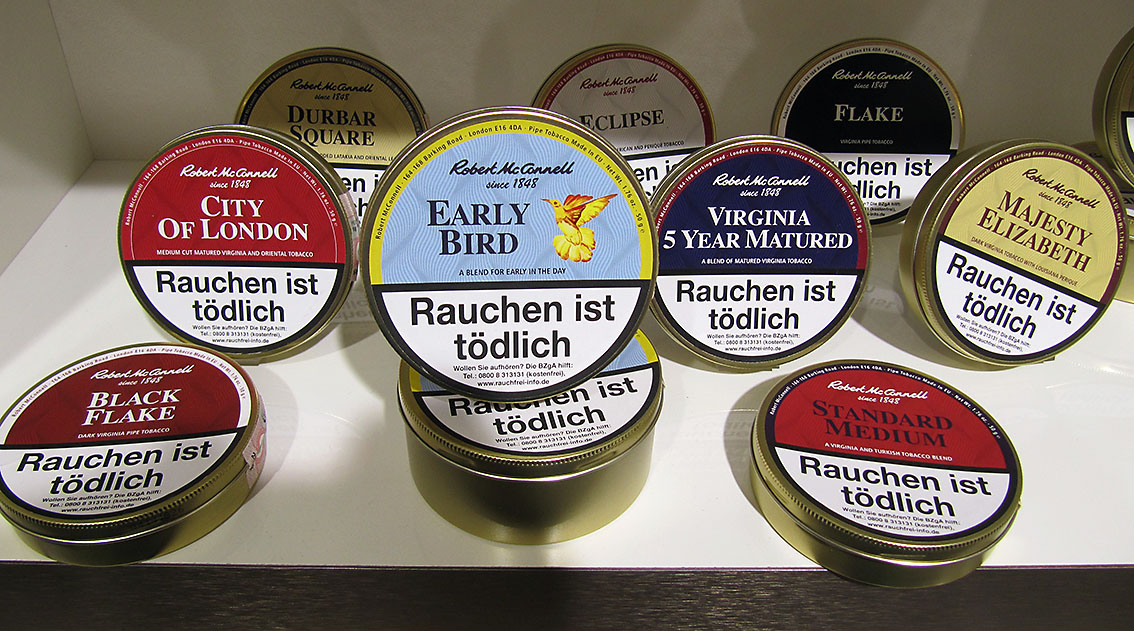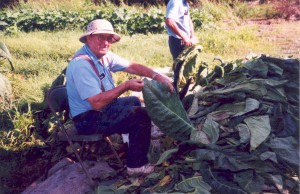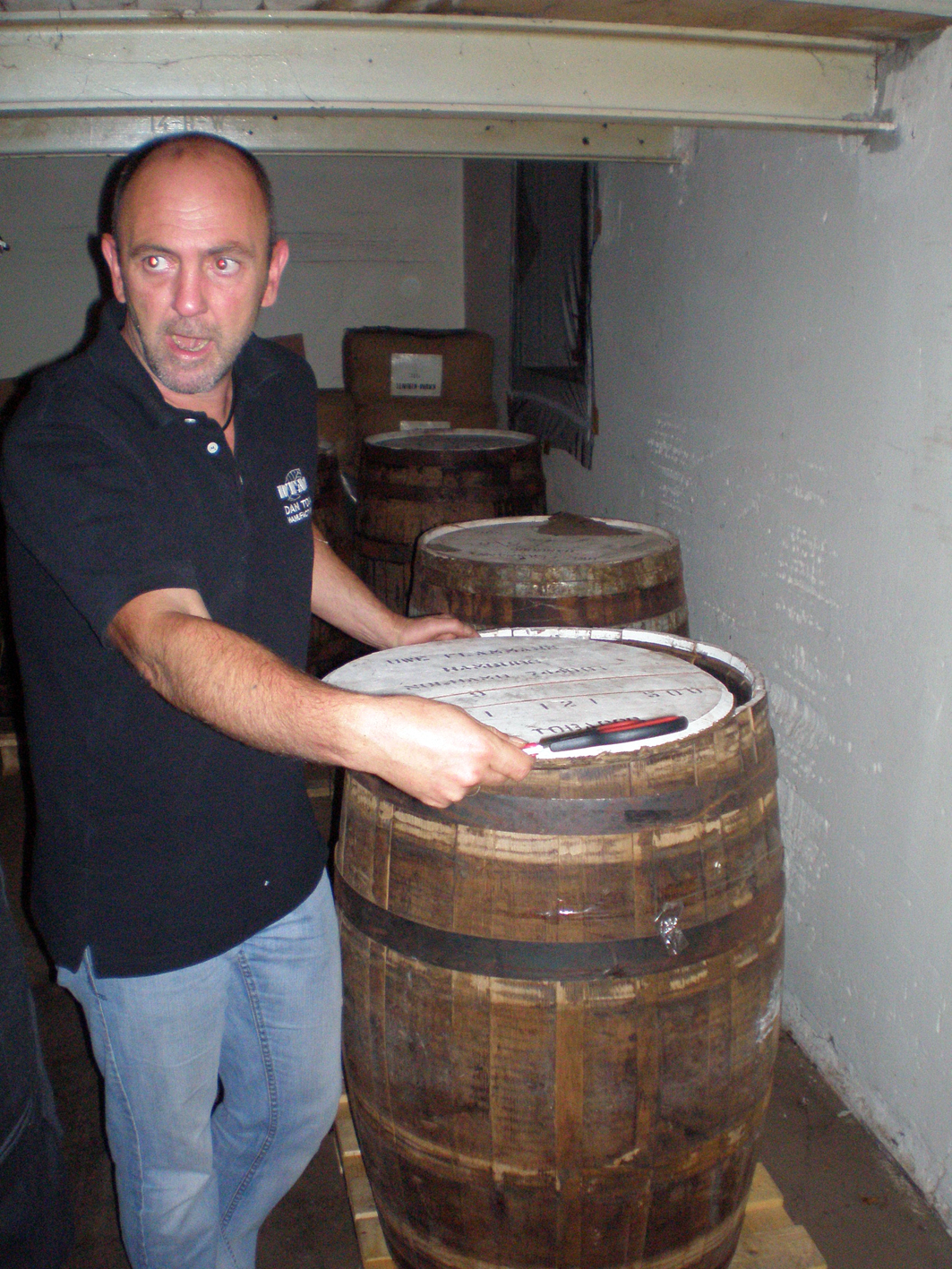September 22nd it was once again time for one of my annual highlights: The Inter Tabac fair in Dortmund. For those of you who missed the blogposts I made of the visit the last couple of years; the Inter-Tabac is the leading and biggest trade fair of the world for tobacco products and smoking accessories. This year 625 exhibitors from 54 countries presented trends and innovative tobacco products. This included cigars, cigarillos, cigarettes, E-cigarettes, E-pipes, E-shishas, smoking accessories, pipes, pipe tobacco, shishas, shop equipment and spirits. Unfortunately the fair is for retailers, not for consumers. Like the previous years I was able to secure a ticket through Fred. The saying goes, the more the merrier, so (with approval of Fred) I invited Jef, who is an enthusiastic Three Nuns tobacco fan (more about that later) and also a member of the Dutch/Belgian Pipe Smokers Forum. Sadly just a day before the fair Fred told me he could not make it. So on the early morning of the 22nd Jef drove from the West of The Netherlands, where he lives, to the East, where I live. To be precisely, to the MacDonalds in Deventer. There is a big parking lot just near the highway so I could park my car there and Jef and I could drive together. He was already there when I arrived and asked me the magic words on an early morning: “Do you want some coffee?”
 We arrived well on time at the Westfalenhallen, the location of the fair, but when we wanted to go to the main entrance we could not find it. Turned out there was a big renovation going on so we had to walk through some sand and mud to get inside.. I proposed to first go to the stand of DTM/Danpipe because, well.. They have coffee there. And excellent tobaccos of course! We were greeted by master-blender Andreas Mund and his charming wife (both DTM employees) who, by the way, is responsible for many of the new DTM blends. Apparantly she has good taste buds, a good smell and some creativity. Jef knew of a perfume site where a lot of smell-combinations are explaned so he told her about it in spotless German. My German is just ok, I can understand it and make clear what I think and want but that’s it. So I looked at Jef and he smiled and shrugged “You probably did not know I am half German right?” No I didn’t but it was damn handy to have a walking translator beside me.
We arrived well on time at the Westfalenhallen, the location of the fair, but when we wanted to go to the main entrance we could not find it. Turned out there was a big renovation going on so we had to walk through some sand and mud to get inside.. I proposed to first go to the stand of DTM/Danpipe because, well.. They have coffee there. And excellent tobaccos of course! We were greeted by master-blender Andreas Mund and his charming wife (both DTM employees) who, by the way, is responsible for many of the new DTM blends. Apparantly she has good taste buds, a good smell and some creativity. Jef knew of a perfume site where a lot of smell-combinations are explaned so he told her about it in spotless German. My German is just ok, I can understand it and make clear what I think and want but that’s it. So I looked at Jef and he smiled and shrugged “You probably did not know I am half German right?” No I didn’t but it was damn handy to have a walking translator beside me.
 Andreas brought us all some coffee and I asked about new blends. DTM only had one called “The Untouchables”. A collaboration between DTM’s Michael Apitz and Hans Wiedemann from HU Tobacco. Very interesting! Andreas handed me the jar containing the blend and I first read the label: The Untouchables Special Mixture: The basic mixture consists of mature ready rubbed Virginia and a pinch of smooth Black Cavendish. Aroma of cedarwood and roses are added as a final seasoning, which marry perfectly with the tobacco’s original flavours. Untouchable – incorruptable in terms of quality! Ok, I opened the jar and it smelled inviting, so I grabbed my pipe and wanted to fill it with the blend. “Whooh! No you can’t!” Andreas said. “Huh, why not?” “Well, ehm.. We were a bit late deciding which aromas would be used so we only have this jar and nothing more..” “Ehrr.. Ok, so you have a new blend and no one can sample it?? You had loads of time to prepare for the fair!” With a laugh Andreas said: “Well, here it goes like, damn, the fair is in a week, let’s come up with something!” Ok, I opted for some tasty Fred the Frog instead. We talked some more about the company and we all believed it is a company that has “soul”.
Andreas brought us all some coffee and I asked about new blends. DTM only had one called “The Untouchables”. A collaboration between DTM’s Michael Apitz and Hans Wiedemann from HU Tobacco. Very interesting! Andreas handed me the jar containing the blend and I first read the label: The Untouchables Special Mixture: The basic mixture consists of mature ready rubbed Virginia and a pinch of smooth Black Cavendish. Aroma of cedarwood and roses are added as a final seasoning, which marry perfectly with the tobacco’s original flavours. Untouchable – incorruptable in terms of quality! Ok, I opened the jar and it smelled inviting, so I grabbed my pipe and wanted to fill it with the blend. “Whooh! No you can’t!” Andreas said. “Huh, why not?” “Well, ehm.. We were a bit late deciding which aromas would be used so we only have this jar and nothing more..” “Ehrr.. Ok, so you have a new blend and no one can sample it?? You had loads of time to prepare for the fair!” With a laugh Andreas said: “Well, here it goes like, damn, the fair is in a week, let’s come up with something!” Ok, I opted for some tasty Fred the Frog instead. We talked some more about the company and we all believed it is a company that has “soul”.
Next we went to the big stand of the mighty MacBaren. This was a highlight for Jef because he is a big fan of the Three Nuns blend (and he knows all about its history) which is made by MacBaren now for a couple of years. Recently 2 new Three Nuns blends came out: Three Nuns Green (containing Kentucky, Perique and Virginia) and Three Nuns Yellow (containing Virginia). I did not have tried any of them, in fact, I did not have tried Three Nuns at all in my pipe smoking life. Until some months ago when I received a full envelope from Jef containing samples of different vintages. Some tasted better than others but still, very good! Jef even brought some of those old blends with him to show to product manager Per Jensen, who greeted us warmly. I just had to say “Three Nuns” and almost like a magician he made the 2 new blends appear on the counter. After an extensive sniffing I decided to load my pipe with the “Green” version. It was fresh as a young virgin but it tasted damn mature! Yummie! Per said: “We never looked back when we created the new blend. We never tried any of the old Three Nuns. Reason is that the tobacco manufacturers back then could lay their hands on does not exist now any more.” We talked some more when the subject came upon Burley. I said I seldom smoked Burleys but was willing to try some. So I asked if I could have a sample of the HH Burley Flake. Promptly I was given a full sealed tin. “That is how we do samples at MacBaren!” said Per with a wink. His next gift was a very special one, a big heavy book called “The Pipe, A Functional Work of Art“. It looked absolutely stunning with beautiful pictures. Thank you very much Per!
When we were chatting and smoking the fabulous Three Nuns a man walked up to the counter. He had an unsmoked corncob pipe in his hand and said to Per he came for his pipe-smoking lesson. It turned out he came from Switzerland, was a cigar aficionado but wanted to explore the world of pipe-smoking. Ah, a possible new convert! Jef had some experience teaching new pipe-smokers so Per and I gave him the thumbs up to go ahead. And I have to say, Jef did a very, very good job. Per and I stood mesmerized while Jef explained all the basics to the man. Beginning with what the man liked to eat and drink in his regular life. Sweet? Not sweet? Smoky? Based on that Jef thought the man would prefer a more natural tobacco. So he let him smell some to show the difference between blends. On my advice the man also held his nose above a mixture with some latakia (some people immediately love it and want nothing else) but he did not like it very much. In the end Jef advised the man to try Amphora Virginia, because it is natural and uncomplicated yet tasty. He then told how to fill a pipe with the 3-step method (first putting in the tobacco like a child, softly, then as a woman, a bit harder and finally as a man, firmly press it). The Swiss man then lighted his pipe and began puffing contently. Jef explained some more basics on how to smoke and clean the pipe. The man loved it, “I can taste my favourite whisky!” he said with a big smile. Later we would bump into him again and he would repeat that he “really liked it, really liked it!” Mission accomplished.
It was already time to lunch and on our way outside we passed the stand of Big Ben. As always Elbert Gubbels was very busy but he took the time to greet us. When I asked how things were going his face contorted: “All those damn EU regulations! Now they want that the Samuel Gawith tins I import no longer have a golden colour. Instead they must have an aluminium look because the gold looks too fancy!” Talking about Gawith, when we were outside having some lunch (which we brought with us because the food prices at the Inter Tabac are utterly insane) I spotted a grey man trying to sneak past us. When he saw I noticed him he tried to get away but to no avail, I gave him a big hug, it was Bob Gregory. “You bastard!” he said, “Every time I look at the bottle of beer you gave me last year I have to laugh! What’s inside huh? Belgian ale? Strong stuff!” Yes Bob, the stuff that makes you grow even more chest hair! Less funny were sadly his stories about, yet again, the EU regulations. I asked him if there was a chance Flatlander Flake would be released worldwide. “No, because the sky is blue.” “Excuse me?” “The sky is blue in the tin art which is not allowed any more. It strikes a too positive note about smoking.” Completely bonkers if you ask me.. “By the way, do you know a place in The Netherlands called Ootmarsum?” Bob asked. “Yes I do, in fact it is not too far away from where I live.” “Good, you should go there to a brewery, forgot which one, and take a good look around.” “Why?” “Because all the old Samuel Gawith machinery and equipment from the Kendal Brown House is there.” “What??? You mean amongst others the legendary old snuff mill from around 1750? The oldest, longest working piece of industrial equipment in Great Britain, perhaps even the world?” “Yup.. After the move to Gawith & Hoggarth we really tried to keep it all in Kendal, in the country. I phoned museum after museum, even the British Museum but no one wanted it.. Such a shame.. In the end a Dutch friend of mine who has a brewery in Ootmarsum bought it all to put in his little museum.” Back home I looked on the internet, the brewery in Ootmarsum must be the Othmar brewery. I think I will visit them soon.
After lunch Jef and I went to the stand of the Scandinavian Tobacco Group. Inside were pipes of brands like Peterson (! I had expected they had gone elsewhere since Laudisi took over the brand), Stanwell, Dunhill and Winslow. Stanwell had some new pipes made out of beech wood. According to the friendly spokes-lady they would last about 300 smokes. Hmm.. That does not add up to much for that price, I thought.. My corncobs are much cheaper and they already last far more than 300 smokes. Peterson had nothing really special and Dunhill had some weird pipes with a bend stem so you can smoke it around a corner or something like that.. Mr. Poul Winslow himself was present and I took the opportunity to thank him for repairing one of my favourite Winslow pipes. Some time ago I bit through the mouthpiece, I contacted my seller and he said to just send the pipe to Denmark for repair. So I did and only a couple of days before the Inter Tabac I got it back, with a new stem and polished. Mr. Winslow immediately recognized the pipe when I showed him, “Ah, the pipe with the broken mouthpiece right?” Further we had a pleasant conversation, he is such a gentleman.
At a side of the stand I spotted a friendly giant: Scandinavian Tobacco Group master-blender Lasse Berg. On a table before him were jars with all kinds of loose tobaccos; Virginias, Burley, Kentucky, Latakia, Perique etc. It turned out he was blending mixtures for whoever who wanted them. That was an opportunity I would not miss! “What do you want?” He asked me. “A good balkan blend please!” With the speed of an experienced blender he put together some orientals, Latakia and Virginia. “Would you like some Perique?” “No thank you.” “A bit of Black Cavendish?” “Yes please.” He deposited it all in a tin and asked me what the name of the blend should be. “Balkan Arno, please”. Later that afternoon I smoked it and I have to say, it was better than expected!
 Next was the stand of Kohlhase & Kopp. What struck us the most were the new “just-like-Dunhill-but-different” blends under the Robert McConnell banner with names like Early Bird (Early Morning Pipe), City of London (London Mixture), Majesty Elizabeth (Elizabethan Mixture) etc. I don’t know what to think of it.. Creative, yes, but also a bit of an insult to the old Dunhill blends. Anyway, Dunhill tobacco already died for me when Murray’s took over. I had the opportunity to smoke several sublime 1970’s versions and they were superior to the later blends I had, Murray’s and Orlik. At Vauen there were few new items. I think a new Auenland and I saw some pipes with weird psychedelic spots on them.
Next was the stand of Kohlhase & Kopp. What struck us the most were the new “just-like-Dunhill-but-different” blends under the Robert McConnell banner with names like Early Bird (Early Morning Pipe), City of London (London Mixture), Majesty Elizabeth (Elizabethan Mixture) etc. I don’t know what to think of it.. Creative, yes, but also a bit of an insult to the old Dunhill blends. Anyway, Dunhill tobacco already died for me when Murray’s took over. I had the opportunity to smoke several sublime 1970’s versions and they were superior to the later blends I had, Murray’s and Orlik. At Vauen there were few new items. I think a new Auenland and I saw some pipes with weird psychedelic spots on them.
 Jef had spotted a brochure that somebody held advertising CBD oil. What the hell does someone want with oil made out of the cannabis plant? Well, sadly Jef’s father has cancer, a very lethal version. The doctors had given him only 6 months but because of the use of CBD oil and Curcuma extract pills he has been going pretty strong for 19 months already! Jef is busy with setting up a business that can import, and perhaps later make, CBD oil in The Netherlands. But he did not expect to find suppliers on the Inter Tabac Fair. So we visited several of them. Pretty interesting, one company even had a vaping device which allowed you to inhale the CBD into your lungs. Handy with patients who have lung cancer for example.
Jef had spotted a brochure that somebody held advertising CBD oil. What the hell does someone want with oil made out of the cannabis plant? Well, sadly Jef’s father has cancer, a very lethal version. The doctors had given him only 6 months but because of the use of CBD oil and Curcuma extract pills he has been going pretty strong for 19 months already! Jef is busy with setting up a business that can import, and perhaps later make, CBD oil in The Netherlands. But he did not expect to find suppliers on the Inter Tabac Fair. So we visited several of them. Pretty interesting, one company even had a vaping device which allowed you to inhale the CBD into your lungs. Handy with patients who have lung cancer for example.
 Because the visits to Danpipe, MacBaren and the CBD companies took so long we could not see the entire fair. But I don’t think we missed much. Oh wait, there was one thing, I missed some scantily dressed promotion babes! It all was very, decent, this year. Until we were in one of the Vaping halls and we saw a stunning bodypainted beauty. Yesss!!! Around 5 o’clock we decided to call it quits and find something to eat. Like every year there was only one location we could go to; El Greco in the town of Herne. The friendly owner more or less recognized me from the other years (“Netherlands, right?”) and the meal he made was as good as ever.
Because the visits to Danpipe, MacBaren and the CBD companies took so long we could not see the entire fair. But I don’t think we missed much. Oh wait, there was one thing, I missed some scantily dressed promotion babes! It all was very, decent, this year. Until we were in one of the Vaping halls and we saw a stunning bodypainted beauty. Yesss!!! Around 5 o’clock we decided to call it quits and find something to eat. Like every year there was only one location we could go to; El Greco in the town of Herne. The friendly owner more or less recognized me from the other years (“Netherlands, right?”) and the meal he made was as good as ever.
I want to thank Jef for keeping me company and for all the interesting conversations we had. All pictures were made by Jef and myself.












